| |
|
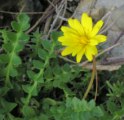 | |
| MaltaWildPlants.com by Stephen Mifsud |

|
| |
|
|
 |  |  |  |
| External Links: |
|
Anagyris foetida (Stinking Bean Trefoil) |
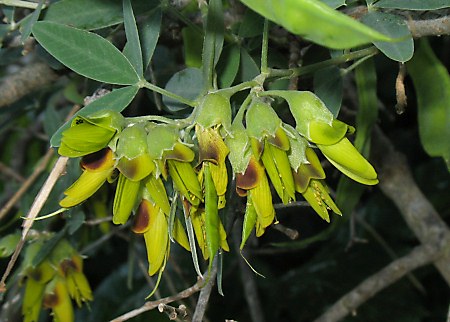
Anagyris foetida (FABACEAE.)
Images for this profile are taken from the Maltese Islands after year 2000. |
|
| Nomenclature |
Species name : | Anagyris foetida L. | Authority : | Carl von Linne, Sweden, (1707 - 1778) | Synonyms :
(basionym or principal syn.) |
|
Plant Family : | Fabaceae Lindl. (= Leguminosae )
(Pea Family) | English name(s) : | Stinking Bean Trefoil, Purging Trefoil, Stinking Wood | Maltese name(s) : | Fula tal-klieb | Status for Malta : | Indigenous. Present on the Maltese islands before man | Name Derivation : |
Anagyris: literally meaning turned backwards circularly, and possibly referring to the legumes that are distinctly curved. (Latin origin ); 2 = Ana- means without or lacking of; while -gyros means around or circular. (Latin);.
foetida: Stinking, possessing a foetid scent. (Latin origin ); 2 = Stinking, foetid, referring to its unpleasant smell of spoiled beans (Latin);.
| Remarks : | |
|
| Morphology and structure |
PLANT STRUCTURE: |
Character | Growth Form | Branching | Surface |
Description | | | |
General
Picture |  |  |  |
|
LEAVES: |
Character | Arrangement | Attachment | Venation |
Description | | | |
General
Picture |  | 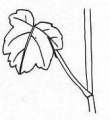 |  |
| |
Character | Leaf Shape | Leaf Margin | Remarks |
Description | | | Leaf Texture Sericeous; the lower side of the leaves bear fine, usually straight, apressed, hairs giving the appearance of a silky texture. Also found on upper side but much more sparse. |
General
Picture | 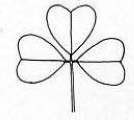 |  |  |
|
FLOWERS: |
Character | Colour | Basic Flower Type | No. of Petals | No. of Sepals |
Description | Yellow-Green The upper petal (=standard) has a brownish-black blob. | | 5 1 upper standard, 2 lateral wings, and 2 bottom keels. | 5 Fused Sepals fused to form a calyx with an undivided structure. |
General
Picture | | 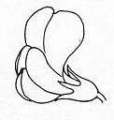 |  |  |
| |
Character | Inflorescence | Description | Ovary | Stamens |
Description | | The 5 yellowish petals are apressed on each other and overlap to form a rather cylindrical or tubular shape. The standard is circular and slightly erect showing its reddish brown or black blobs. The keel and wings are oval, undecorated and similar to each other. | | |
General
Picture |  |  | 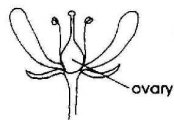 | 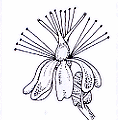 |
| |
Character | Scent | Average Flower Size | Pollen Colour | Other Notes |
Description | YES The flowers and most of the plant gives off a foetid smell of spoiled beans. | 22mm x 6mm x 5mm Length x width x height. | Yolk-yellow | - |
|
SEEDS: |
Character | No. Per Fruit | Shape | Size | Colour |
Description | 4-12 | Reniform Broad, kidney-shaped structure. They are very hard and posoinous. | 13mm x 9mm x 5mm (Length x Breadth x Height). | Purple-Black Occasionally found uncoloured (pale yellow). |
General
Picture |  |  |  |  |
|
FRUIT AND OTHER BOTANICAL DATA: |
Character | Fruit Type | Colour of Fruit | Subterranean Parts | Other Notes |
Description | | Dark Brown / Black Bright green when immature. | | Seed texture Seeds are very hard with a smooth surface as if made of glass. |
General
Picture |  |  |  |  |
|
|
| Plant description and characters | |
Life Cycle: | Perennial. |
Growth Form: | Macro-Phanerophyte (high trees usually over 10 m high ) |
Habitat: | Rocky slopes at sheltered areas such as at valley sides or maquis. |
Frequency: | Rare |
Localities in Malta: | Rare, found at few localities of which the largest population is that of San Pawl tat-Targa/Wied Anglu whereas in the other few localities, it is found in few or even singular numbers (eg. Mtarfa). |
Plant Height: | 1m to 3m. |
| Jan-Feb |
Protection in Malta: | Protected by law: Schedule I of [S.L. 549.123] AND schedule III of [S.L. 549.44] (Strictly protected tree species) |
Red List 1989: | Threatened status for the Maltese Islands and has been listed in the Red Data Book (1st ed.) |
Poison: | |
The leaves are stalked and grows in an alternating fashion along the stems. They are formed in sets of 3 leaflets (trifoliate) each having a simple pinnate venation. The leaflets are nearly identical, with the central one being slightly larger. They large leaflets are often about 35mm long and 12mm wide. Leaflets have an entire outline and a lanceolate shape, sometimes fusiform (elliptical shape). In Summer the leaves are dropped and grow again the following Autumn after the first rains, hence making the plant to be described as deciduous. The short, inconspicuous and apressed stipule is found opposite the leaf.
The flowers are arranged in racemes, with 5-12 flowers per raceme. Each flower have a 8-12mm long pedicel followed by a gamosepalous (fused-sepals) calyx and yellow-green corolla. The bell-shaped calyx have 5 teeth (or triangular lobes) where the upper 2 being smaller and more near to each other.
As in most Fabaceae species, the corolla is basically composed of 5 petals, the upper standard, 2 lateral wings, and 2 central and lower ones known as the keel. These are compact and apressed to form a closed tube. The standard has a circular shape with a diameter of about 12-13mm and is the only petal which is decorated with dark brown or black blob, or strictly speaking a collection of smaller blobs close to each other. The wings and keel are of same oblong shape, about 16mm long, undecorated with longitudinal veins.
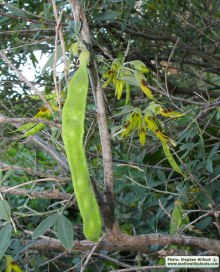 Most of the reproductive organs are hidden inside the corolla tube. There are 10 free stamens (with yellow anthers) of unequal length arranged as a bundle around the central pistil. The latter consists of an elongated superior ovary, and a long style with its tip (stigma) usually found protruding out from the corolla.
Most of the reproductive organs are hidden inside the corolla tube. There are 10 free stamens (with yellow anthers) of unequal length arranged as a bundle around the central pistil. The latter consists of an elongated superior ovary, and a long style with its tip (stigma) usually found protruding out from the corolla.
The ovary develops into a flattened legume which varies in length and number of seeds - 3-12 per pod. The longest legumes are about 15-18cm long and 15-20mm wide. They are more or less oblong structures (with rounded ends), curved backwards and somehow crooked. The seeds can be seen bulging out in the narrow pods (just 3mm wide). The legume has a thread-like tip, previously the style of the flower.
The legumes matures in Summer where they become brown and dehisce to release the seeds inside. The seeds are broad, kidney-shaped structures about 14mm long, 9mm wide and 5mm broad. Normally, they have a dark-purple to black colour, very hard and smooth surface.
|
|
| Information, uses and other details |
Nativity and distribution
The distributional range of this plant is shown in the list below: [WWW-26, WWW-158]
Northern Africa: Algeria , Libya , Morocco, Tunisia
Western Asia: Egypt - Sinai, Iran, Iraq, Israel, Jordan, Lebanon, Syria , Turkey
Europe: Albania, Bulgaria, Corsica, Croatia, Cyprus, France, Greece, Italy, Jugoslavia, Portugal, Sardegnia, Sicily, Spain.
Its origin is believed to be North Africa, Mediterranean and South Europe [383]
Pollination of Anagyris foetida by birds
The pollination of Anagyris foetida L. (Fabaceae), a Mediterranean species that is a relict of the Tertiary, was studied in two populations of SW Spain over a three-year period. Numerous censuses of birds and insects were carried out, the floral nectar was quantified, and specific tests were performed to determine the pollinators' pollen load, the pollen's effective transfer to the pistil, and spontaneous self-pollination. The most important pollinators were three species of passeriforms Phylloscopus collybita Vieillot, Sylvia atricapilla L. and S. melanocephala Gmelin - a result coherent with findings in populations of S and E Spain. The negligible existence of insect visitors and pollinators of A. foetida flowers could be explained by the early flowering of this species during the autumn-winter, coinciding with the coolest and wettest months of the year (cold, high winds, almost daily mists that persist until nightfall, and above all, abundant rainfall). The pollen loads carried by the birds were high, as were also the loads transferred to the pistil. The fruit-set of bagged flowers was very low, evidence of the plant's need for the birds as pollinators. This is the first proof of the existence of a native European bird-pollinated plant, since besides ifs peculaliarities (flowers odourless, pseudotubular, with no landing platform, pendulous, diurnal populations were mainly pollinated by three passeriform species. [388]
The alkaloid anagyrine from Anagyris foetida
Hardy and Gallois have separated from Anagyris foetida an alkaloid, anagyrine. Parthiel and Spasski found that the crude alkaloid could be separated into cytisine, C11H14N2O and anagyrine, C15H22N2O; the latter is not obtainable in crystalline form; it forms a brittle, resinous-like mass easily reducible to a yellowish powder, but rapidly absorbs moisture and becomes sticky. It volatilizes at 245� C. (473� F.). (Arch. d. Pharm., 244, No. 1, 1906, 20.) It forms, however, a crystalline hydrobromide. [387]
Anagyrine hydrobromide, which has the formula C14H18N2O2HBr, occurs in colorless or faintly yellow crystals and soluble in water. Anagyrine, according to Loewi (A. I. P., vol. vii, p. 66), is physiologically related to lobeline, acting primarily upon the nerve endings as a paralyzant and later upon nerve centers, but having no direct influence upon the muscles. It lessens the cardiac frequency and decreases the force of the systole in the frog, but is said in the mammal to have very little influence upon the blood pressure, death occurring through respiratory paralysis. [387]
Medicinal Uses
The plant has the following medicinal properties according to reference: [WWW-66] , [359] .
| Cathartic |
Cleansing the bowels; promoting evacuations by stool; purgative. [WWW-32] |
| Constipation |
- [WWW-57] |
| Emetic |
An agent that causes vomiting, so as the stomach is emptied from its contents. [WWW-57] |
| Laxative |
Having the effect of loosening or opening the intestines, hence stimulating evacuation of feces and so relieving from constipation. [WWW-32] |
| Lithiasis |
An agent used against the formation of stones (calculi) in an internal organ [WWW-32] |
| Nephretic |
An agent usd to treat inflammation of the kidney [WWW-32] |
| Pectoral |
A medicine for diseases of the chest organs, especially the lungs [WWW-57] |
| Purgative |
A purging medicine; stimulates evacuation of the bowels. [WWW-32] |
| Tumor |
Used to treat or reduce growth of tumors |
| Vermifuge |
A medicine or substance that expels worms from animal bodies; an anthelmintic. [WWW-57] |
Cytotoxic constituents from Anagyris foetida leaves.
Anagyris foetida extracts were investigated in preliminary cytotoxic tests against two tumour cell lines. Chromatographic separations on active extracts led to the isolation of two alkaloids, anagyrine (1) and baptifoline (2), as well of isorhamnetin (3) and syringin 4-O-beta-D-glucopyranoside (4). In vitro cytotoxicity of compounds 1-3 was also evaluated. [390]
Rhombifoline and 5,6-dehydroLupinine from Anagyrus foetida
Rhombifoline and 5,6-dehydroLupinine were isolated for the first time from the leaves and stems of A. foetida L. indigenous to Saudi Arabia. In addition, five other alkaloids, previously identified in A. foetidia L., namely N-methylcytisine, sparteine, anagyrine, Lupinine and cytisine, were isolated. The isolated alkaloids were characterized by UV, 1H-NMR, 13C-NMR and Mass spectral data. 13C-NMR data of rhombifoline and 5,6-dehydroLupinine are reported for the first time. [391]
Toxicity Notes
The following toxicity notes about A. foetida were extracted frm reference [WWW-173] :
Toxic parts: all but particularly seeds
Active ingredients: two alkaloids, the cytisine and the anagyrine
Circumstances of intoxication: ingestion by the man at the time of confusion with bean pods and consumption by the cattle
Toxicity: described in the child like in the horses and the bovines and sheep (more rarely because the odor of the shrub is dissuasive)
Target body: Nervous system (ganglionic poison)
Symptoms: they appear 4 to 5 a.m. after the seed ingestion: mydriase, excitation, driving incoordination and giddinesses, associated sudation, salivation, colics and convulsions. In the severe cases, the coma then death by asphyxiation occur in the 4 hours after the appearance of the symptoms. The ingestion of sheets involves vomiting and a violent purging.
Livestock productions: elimination of the cytisine in the milk which becomes toxic and present yellow clots.
Main Toxic alkaloids of A. foetida
From the chapters above, the most important toxic alkaloids present in the Stinking bean trefoil are Sparteine, Lupinine, Anagyrine, and Cytisine of which the last two are the most dangerous.
Sparteine: This is a class 1a antiarrhythmic agent [WWW-60] , an alkaloid isolated from lupin beans, Lupinus luteus and Lupinus niger. It has been used as an oxytocic and an anti-arrhythmia agent. It has also been of interest because of genetic variation in its metabolism. [WWW-174]
Lupinine: The seed of modern cultivars of Lupinus angustifolius normally contain less than 0.03% alkaloids. The acute oral LD50 to rats of a pro rata mixture of the alkaloids of L. angustifolius seed was found to be 2279 mg/kg. For Lupinine the LD50 by oral administration was 1464 mg/kg and by intraperitoneal injection 177 mg/kg. For 13-hydroxyLupinine the LD50 by intraperitoneal injection was 199 mg/kg. Since these two alkaloids comprise about 85% of the total and are known to be rapidly cleared from the body it is suggested that the alkaloids in this species do not pose a health problem for man. [393] Lupinine, a quinolizidine alkaloid, induces nicotinic effects in animals. Leaves, seeds and fruits all contain lupinine, which is retained in dried plants. Pods may concentrate the toxin, becoming a source of poisoning during the winter season when livestock are moved through infested areas or contaminated hay is fed. [WWW-135] . Lupinine is reported to cause the following symptoms: Birth defects, spasms, vomiting, nausea, dizziness, headache, abdominal pain, & in severe cases death. [WWW-176]
Anagyrine: C15H20N2O A toxic alkaloid found in several species of Lupinus in the western United States; acute poisoning produces nervousness, depression, loss of muscular control, convulsions, and coma. [WWW-125] This alkaloid causes the "crooked calf syndrome" (i.e., carpal flexure, torticollis and scoliosis in calves exposed in utero during days 40-70 of gestation). [WWW-135]
Cytisine: Cytisine is a toxic pyridine-like alkaloid. Pharmacologically it exhibits similar effects to nicotine due to structural similarity of the two molecules. In large doses it can interfere with respiration and become fatal. [WWW-60] Cytisine is a nicotine agonist, and as a pharmaceutical preparation it is available for the treatment of nicotinism. Cytisine derivative varenicline was approved in 2006 as a smoking cessation drug. A 2006 literature review concludes that while trials performed with cytisine itself are mostly of poor quality, there is some evidence that cytisine may be prescribed to aid in smoking cessation. [WWW-125] Cytisine is reported to cause the following symptoms: Nausea, vomiting, abdominal pain, diarrhea, drowsiness, headache, dizziness, fever, irregular heartbeat, dilated pupils. Severe cases can have convulsions, coma & death. The toxicity varies widely. [WWW-176]
Plants containing cytisine, including the Common Broom and Mescalbean have also been used recreationally. Positive effects are reported to include a mild intoxication and heightened awareness of color. However this practice is not recommended since negative side-effects can include nausea, vomiting, convulsions, heart pain, headache and in larger doses even death via respiratory failure. Plants that contain the alkaloid in various concentrations include several from the Faboideae subfamily, including laburnum, anagyris, thermopsis, cytisus, genista and sophora. [WWW-125]
Cases of toxicity from anagyrine in lupin plants
Silky lupine (Lupinus sericeus) is a native herb of western Canada. This lupine has caused poisoning and death in cattle, goats, horses, and sheep. Sheep eat the plants more readily than do other animals and are therefore more commonly poisoned. Cattle also suffer from crooked calf disease, a teratogenic syndrome caused by maternal ingestion of certain lupines between day 40 and day 70 of gestation. The calves can suffer from arthrogryposis, scoliosis, and other deformities. Humans are also at risk from lupine toxins. In one case in California, a child was born with limb deformities. The family raised milk goats that had also given birth to kids with deformed limbs, and a dog gave birth to deformed pups. All had ingested the goat''s milk during pregnancy. Anagyrine in a local lupine species was believed to cause the problem. Tests showed that lactating goats that ingest lupine seeds pass anagyrine in the milk. Edible lupine seeds are being marketed in health food stores. In Edmonton (Smith 1987), a woman suffered mild dizziness and incoordination after ingesting the seeds. She did not follow specific instructions to soak and boil the seeds in several changes of water, which is necessary to remove the toxins. [WWW-175]
Binding of quinolizidine alkaloids to nicotinic and muscarinic acetylcholine receptors.
Fourteen quinolizidine alkaloids, isolated from Lupinus albus, L. mutabilis, and Anagyris foetida, were analyzed for their affinity for nicotinic and/or muscarinic acetylcholine receptors. Of the compounds tested, the alpha-pyridones, N-methylcytisine and cytisine, showed the highest affinities at the nicotinic receptor, while several quinolizidine alkaloid types were especially active at the muscarinic receptor. [389]
Personal Observations
The blotch on the standard
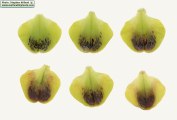 On examining several flowers of the same specimen, I found two different types of dark blotches on the standard petal. One type of blotch consisted of a cluster of very small, isolated and well defined specs which where as black as coal. The other type of consisted of a singular iodine-brown blotch. All other blotches fell as gradual intermediates between the two extreme types described. On further study it was noted that the blossoming flower had the former type of blackish blotch and as if the colour diffuses gradually with flower age across the petal to form the other brownish type of blotch. On a similar note, blossomed flowers had a yellow-green corolla while mature ones turn to a more golden hue of yellow.
On examining several flowers of the same specimen, I found two different types of dark blotches on the standard petal. One type of blotch consisted of a cluster of very small, isolated and well defined specs which where as black as coal. The other type of consisted of a singular iodine-brown blotch. All other blotches fell as gradual intermediates between the two extreme types described. On further study it was noted that the blossoming flower had the former type of blackish blotch and as if the colour diffuses gradually with flower age across the petal to form the other brownish type of blotch. On a similar note, blossomed flowers had a yellow-green corolla while mature ones turn to a more golden hue of yellow.
Odour of the plant
Personally, I do not find the odour of this plant very stinking. It has a strong smell of boiled or cooked beans, but not an unpleasant one.
|
|
| Links & Further literature
(0 papers) |

Google Web |

Google Images |

Google Scholar |

Research Gate |

Wikipedia |

JSTOR |

GBIF |

Med Checklist |

Cat. of Life |

EoL |

IPNI |

World Flora Online |

Plants of the World Online |

Vienna Virt. Herb. |

RBGE Herbarium |

KEW Herbarium |

MNHN |

Arkive |

IUCN |

CABI |
Kindly Email if there are papers and publications about local
studies or information about this species to be included in the list above.
|
| Photo Gallery (36 Images) | 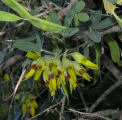 |
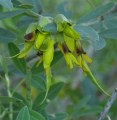 |
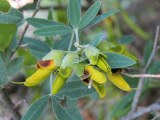 |
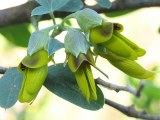 |
IMAGE: AGYFT-01 Photo of showing inflorescence and also some trefoil leaves and part of the immature pods. |
IMAGE: AGYFT-02 Photo of inflorescence, a raceme of 5-12 yellow-green flowers that blossom gradually one after the other. As shown here, some flowers have already developed an ovary while others have just blossomed. |
IMAGE: AGYFT-03 Photo of flowers having a gamosepalous calyx and a corolla of 5 overlapping petals. The upper petal is called the standard and is slightly erect. There are 2 pairs of nearly identical petals, apressed on each other of which the lateral are called the wings, and the lower ones as the keel. |
IMAGE: AGYFT-04 Photo of flowers showing their lateral and upper parts. |
 |
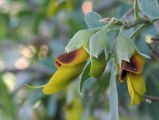 |
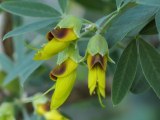 |
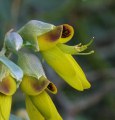 |
IMAGE: AGYFT-05 Photo of few flowers showing the detail of the calyx - a bell-shaped structure with 5 pointed lobes (teeth), of which the upper 2 are closer to each other. The calyx is covered with very short, white hair. |
IMAGE: AGYFT-06 Photo of 2 flowers (and a bud). The standard has a circular shape and have a reddish-brown, or sometimes black blotch. |
IMAGE: AGYFT-07 Another photo of the yellow-green flowers stained with a contrasting iodine-brown blotch on their upper petal. |
IMAGE: AGYFT-08 Close up photo of a flower showing the detail of both the petals and the exposed reproductive organs. There is a bundle of 10 free stamens around a central pistil slightly longer from the stamens - all curved up. |
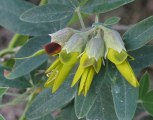 |
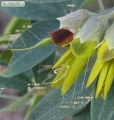 |
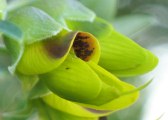 |
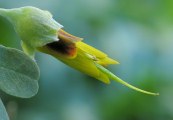 |
IMAGE: AGYFT-09 Photo of 4 flowers with their petals slightly separated in the older flowers. |
IMAGE: AGYFT-10 Close up photo of one of the flowers in the previous photo with annotated explanations of the main flowering parts. |
IMAGE: AGYFT-11 Close up photo of the flower with an attempt to catch the detail of the dark coloration of the standard. |
IMAGE: AGYFT-12 Close up photo of a flower (top view). Note the protruding pistil, which starts to elongate already from the flowering phase. |
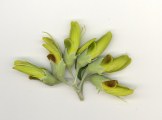 |
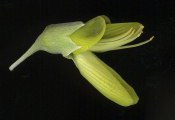 |
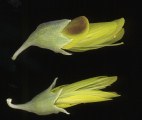 |
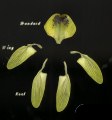 |
IMAGE: AGYFT-13 Scanned image of the pedicelled flowers which are arranged as a raceme. |
IMAGE: AGYFT-14 Scanned, side view image of a flower. One of the wings was removed and the lower pair of petals (keel) was pushed down so as to show better the reproductive parts. |
IMAGE: AGYFT-15 Scanned image of 2 flowers - lateral view and bottom view. |
IMAGE: AGYFT-16 Scanned image of the petals dissected out from the flower. Note the longitudinal veins of the wings and keel. |
 |
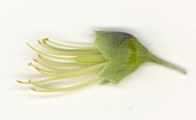 |
 |
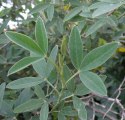 |
IMAGE: AGYFT-17 Scanned image of 6 standards from the same specimen. Some have a brownish, diffused blotch, while others have a set of well-defined black blobs. According to my observations, a young flower initially have a set of dark blobs as in the example at the top left corner and the colour gradually diffuses out forming a singular iodine-brown blotch as in the bottom right petal. It is also observed that younger flowers have a greener yellow petals. |
IMAGE: AGYFT-18 Scanned image of the bundle of stamens, which are free and have unequal lengths. Also visible is the pistil with a slightly hairy ovary. |
IMAGE: AGYFT-19 Photo of the buds. |
IMAGE: AGYFT-20 Photo of the leaves, which consists of 3 identical leaflets each having an elliptic(fusiform) or lanceolate shape. |
 |
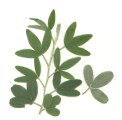 |
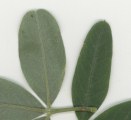 |
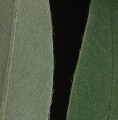 |
IMAGE: AGYFT-21 Photo of the trifoliate leaf. The central leaflet is slightly bigger from the lateral ones. Leaflets have an entire outline and show simple pinnate venation. |
IMAGE: AGYFT-22 Scanned image of a twig with alternating trefoil leaves. The underside of the leaf is grayish-green. |
IMAGE: AGYFT-23 Scanned image of 2 leaves where the one at the left shows the lower face. The latter have much more short hairs, giving it the grayish-green appearance. |
IMAGE: AGYFT-24 Enlarged scanned image of leaf outline (lower side at the left) showing the sericeous (silky) short hairs. |
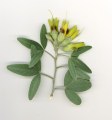 |
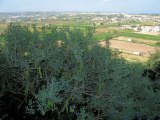 |
 |
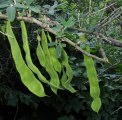 |
IMAGE: AGYFT-25 Scanned image of a twig with leaves and inflorescence. Each leaf has a tiny stipule at the opposite side of the stem. |
IMAGE: AGYFT-26 Photo of plant, which grows into a large bush, 1, 2 or even 3m across. Some reports describes it up to 3-4m high. |
IMAGE: AGYFT-27 Photo of fruit and flowers in situ. Fruit is a legume which can have between 3 -12 seeds. |
IMAGE: AGYFT-28 Photo of a group of fruit hanging down like those of Ceratonia siliqua. They are oblong structures which are narrow and somehow crooked. |
 |
 |
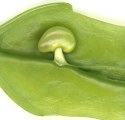 |
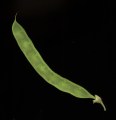 |
IMAGE: AGYFT-29 Photo of fruit against light showing the seeds (ovules) inside which are well separated from each other. Seeds are seen bulging out from the narrow legume. |
IMAGE: AGYFT-30 Scanned image of fruit, dissected open to show ovules inside. |
IMAGE: AGYFT-31 Scanned and magnified image of one ovule. |
IMAGE: AGYFT-32 Scanned image of the legume; 10-18cm long, 2cm wide, slightly curved back. |
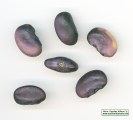 |
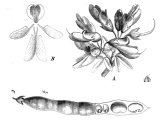 |
 |
 |
IMAGE: AGYFT-33 Scanned image of the seeds. They are broad, kidney-shaped bodies, which usually have a purple-black colour. They are very hard with a smooth surface. |
IMAGE: AGYFT-34 Illustration from Natürliche Pflanzenfamilien. Vol. III, 3. by Paul Hermann Wilhelm Taubert (1862-1897). |
IMAGE: AGYFT-35 Photo of 2 weeks old seedling with fleshy, large cotyledons, and a small trefoil leaf. |
IMAGE: AGYFT-36 Photo of seedling of Anagyris foetida. |
|
| | |

